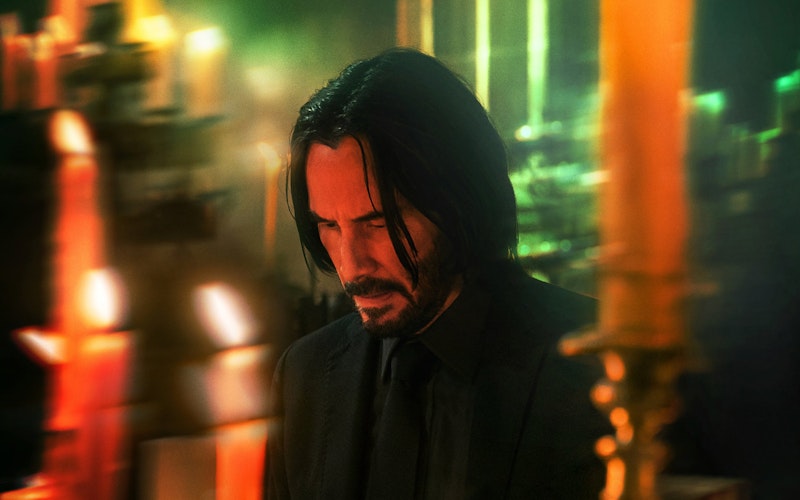
Movies
John Wick’s Cursed Life Under the Law
Editor’s note: This post contains spoilers for John Wick: Chapter 4.
Even when John Wick visits churches, he ends up getting shot.
John Wick: Chapter 4 opens with a quote from Dante’s Inferno, ringing out in Laurence Fishburne’s baritone: “Abandon all hope, ye who enter here.” Dante is an appropriate herald for Wick’s underworld. Make no mistake, death reigns here.
The John Wick films are animated by a simple, uniting principle: Action movies are a blast. For all the fun the audience is having, though, Wick (Keanu Reeves) has a pretty miserable time. He once again has a bounty on his head, put in place by the mysterious High Table, the puppeteers who maneuver the series’ complex world of assassins. This time, the Table has outsourced its work to the Marquis de Gramont (Bill Skarsgård), a man as showy with his violence as he is with his wealth. The Marquis opts for a scorched-earth approach, destroying the New York Continental Hotel run by Wick confidante Winston (Ian McShane) and executing its concierge, Charon (Lance Reddick).
Wick has few options left. He first seeks solace in Osaka, where he trusts in the kindness of Shimazu (Hiroyuki Sanada), but the Marquis’ men are close behind. Leading them is the blind assassin Caine (Donnie Yen), another old friend of Wick’s—now forced by the Marquis to hunt him down, otherwise the Marquis will target Caine's daughter. It’s in Osaka that Chapter 4 begins to fully bloom, both in its breaths of repose and in its marathon fights. Before his quest is complete, Wick’s vengeance will also carry him to New York, Berlin, and Paris. As each setting unravels its own flavor of chaos, cinematic echoes ring out: Akira Kurosawa’s samurai classics, Sergio Leone’s spaghetti Westerns, the bleak midcentury noir of France’s Jean-Pierre Melville and Japan’s Seijun Suzuki, and the comedic sensibilities of Buster Keaton and Charlie Chaplin.
Returning director Chad Stahelski uses these homages to enrich the genre texture of the film, but all the best influences would be of little value without the right performers. Thankfully, Stahelski has formed an inspired cast. Sanada and Yen are magnetic in their roles, while Skarsgård and Shamier Anderson (playing the mercenary Mr. Nobody) revel in the absurdities of their characters (Mr. Nobody’s partner in assassination is a dog). Meanwhile, Reeves wears Wick’s titanic exhaustion in every pause and punch—he almost wishes for the next enemy to end it all. His tenor is matched by everyone around him, particularly in Caine’s disdain and Winston’s bitterness.
As the brawls stretch ad infinitum, there’s a sense that we’ve been here before. Stahelski wisely molds that into the series’ design by framing John Wick as a mythical figure—he’s been likened to one since the very first film—most closely resembling the doomed, hubristic figures of Greek myth. These are characters resigned to their damnation. Fittingly, the film is cast in Underworld grandeur: this world may be stylish, but it’s thick with the stench of death. The world of John Wick is ordered by the Byzantine rules of the Table. The Table presides as a deity; their law determines the assassins’ fates. Can such a world offer any real hope?
Make no mistake, death reigns here.
In 2 Corinthians, Paul contrasts the new covenant of the Spirit with the old covenant of the Mosaic law: “. . . for the letter [of the law] kills, but the Spirit gives life.” Paul expands on this in his letter to the Galatians as he navigates the tension between faith and the law. Paul writes in Galatians 3 that “all who rely on the works of the law are under a curse, as it is written: ‘Cursed is everyone who does not continue to do everything written in the Book of the Law.’ Clearly no one who relies on the law is justified before God, because ‘the righteous will live by faith.’” Yet this is precisely Wick’s aim: to obtain his freedom by satisfying all the demands of the Table. But the Table is a cruel god with impossible expectations. With the Table, there is no new covenant of faith, only a law of lingering false promises and the bitter fruit of further bloodshed.
Wick is under the very curse that Paul described, but he either doesn’t realize the futility of his efforts or he can’t imagine a different path. However, there is another path in view, albeit dimly—a sliver of grace pervades the film, visible in the sacrifices others are willing to make. Shimazu, Mr. Nobody, Winston, and ultimately Caine all show Wick unearned generosity. Some of these sacrifices are minor, some are ultimate, but all allow Wick some freedom outside of the Table’s law.
In Galatians, Paul also understands sacrifice as the initiating act to a new life: “Christ redeemed us from the curse of the law by becoming a curse for us.” Jesus’ life, death, and resurrection grant us freedom: “Now that this faith has come, we are no longer under a guardian.” Paul also proclaims, “It is for freedom that Christ has set us free.” This exhortation to the Galatian church encourages us, also, to joyfully embrace freedom through faith in Christ and to reject the temptation of returning to the law as a means for justification.
John Wick, however, opts for law. The kindness of friends can only get him so far. His choice is a self-defeating one. After besting the Marquis in the climax, Wick collapses on the steps of Paris’ landmark church, Sacré-Cœur, and watches the beauty of a final sunrise. The High Table has indeed set him free—but only for death. In the end, the Table’s law could not impart life. In Wick’s world, where rules limit the boundaries of hope and grace is short-lived, death might be the only freedom on offer.
Topics: Movies